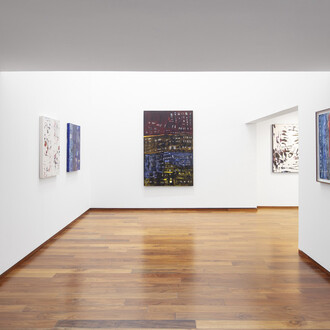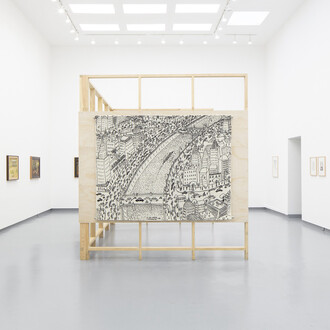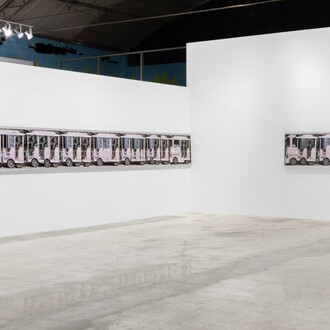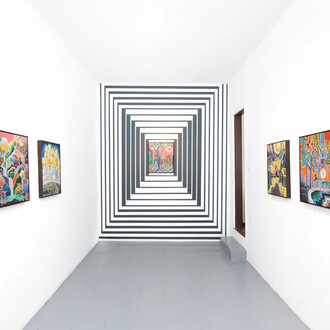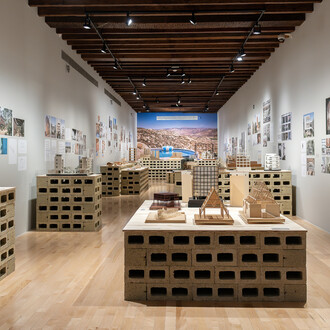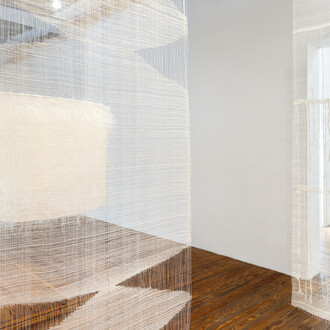Over the course of five decades, Eduardo Terrazas (b. Guadalajara, 1936) has focused on a reconquest of beauty by means of a perhaps not-so-unattainable utopia: containing and representing the perpetual movement of our presence in the world. It is within this cosmic reordering—where the earth is surrounded by four forces: gravity, electromagnetism, strong and weak nuclear energy—that Universe’s previously unknown works also find a place. At first sight, we could infer that the three series that make up this set of artworks (Traces, Textures and Universe) are preliminary notes on the cosmos’s infinite, miniscule variations. We might also state they are strokes suffused in the avant-garde, or indeed, in post-war artistic movements; since in them we see influences from Kandinsky’s symbolic gesturing, Henri Michaux’s psychic calligraphies, Jean Dubuffet’s Texturologies or the dynamism of Gordon Onslow Ford. That said— and even if either of these two suppositions might be unequivocal—when Terrazas firmly asserts “we’ve forgotten beauty,” shattered since the A-bomb first rocked the world, an event the artist has called “the watershed,” hypotheses regarding these works’ origins not only transform but also cast us into the deepest part of the artist’s sensible, perceptive and earthly gaze.
Terrazas’s encyclopedic interest in understanding the gear-works of culture and society that drive the world’s exponential growth declares to us that these artworks are not sketches and they are not solely dictated by impulsive, modern gesturing.
From there we must intuit that the oscillatory drawings in the Traces series are not fragments of imprecise writing, but rather, fibers and nervures, elastic atoms that attract and repel; that the agitated, twinkling lines are in fact tangible images of that metaphysical Cosmos. These artworks, expressive and organic—and as such, residing far removed from abstract-geometric language—untangle the possibility of making textures, forces, speeds and magnitudes visible, alongside geologic and celestial spaces and primeval elements that interest the artist: water, earth, fire and air. Put another way, in his Cosmos’s perpetual and infinite movement, there are not just trajectories and systems; the air also abounds in atmospheric noises, vapors, gases, dusts, molecules and particles. When we suppose these all-but-microscopic substances and matter can be made visible, we move into a key moment for understanding how the artist never stops measuring and evaluating the universe’s evolution.
In the series entitled Textures we encounter two dimensions that allow us to understand this kaleidoscopic, inquisitive thinking. Half of the drawings are made up of firm marks, impetuous strokes, dots and precipitate lines that fall across the paper haphazardly, easily confused with frottage on stones or scratched up soils. Yet their appearance is as undefined as that of persistent images; i.e., the images that remain in our minds for a short lapse after we close our eyes. Such images are not precise, nor do they represent the reality we observe; they are more like abstract, passing images that occur as an optical phenomenon and that dissipate as soon as the moment has passed. In the same way, in Textures drawings, our perceptions are modified each time we look; lines cut each other off and contract to create weaves as well as imprecise, weightless surfaces. The other half of the drawings are even more compact, notable for geometric bodies traversed by half-curves and perpendicular strokes. These oscillating reticles seem to announce the traits of a narrow architecture, perhaps pointing to another theme that interests the artist: density as a magnitude that represents the human imprint and the vast propagation of things. As a whole, Textures uses a microscopic gaze to summarize what we imagine to be incorporeal and invisible, but that simultaneously fosters the earth’s condensation.
That the exhibition’s title is specifically Universe is no coincidence. Nor is it accidental that the eponymous paintings take on all the drawings’ traits with greater sensibility. In the paintings, Terrazas covers the surface of the canvas with layers of acrylic, which simultaneously scratches and cracks, revealing a framework for visions both cosmic and earthly. Behind each rupture we again catch sight of both magnitudes, such as density and velocity, as well as an intention to remove everything not needed. Ultimately, Universe offers us a metaphorical vision of the world that never abandons the possibility of speculating on the acceleration of the future and the search for beauty.





